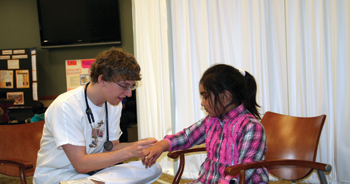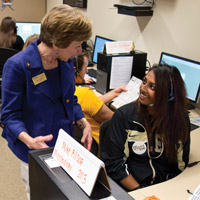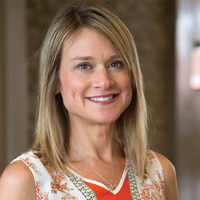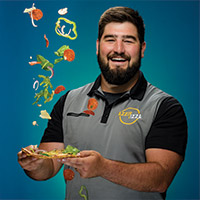A Living Legacy 50 Years in the Making
School of Nursing
celebrates a half-century
of teaching excellence
Future outcomes

Undergrad Outreach: Garrett Thomason (NUR '11) was among 75 undergraduate nursing students who joined 10 faculty and 11 pediatric nurse practitioner graduate students at well child screenings in Purdue Village in 2011. In all, about 200 children of Purdue graduate students received physical exams, health education, hemoglobin and lead screenings and immunizations. (Photo by Melissa Swathwood)
Today, the School of Nursing is building upon the legacy of Johnson and the school's success over the past 50 years, striving to build the program into one that serves the needs of students — and the health care needs of the citizens of Indiana and the country — even better.
"This is such a pivotal time for the nursing profession. Change in health care, nursing practice and nursing education is happening at unprecedented rates," says Jane Kirkpatrick, head of the School of Nursing. "Today, more than ever, nurses need to be equipped for a dynamic health care system."
She describes this change in nursing education as a shift from learning simply the "whats" of nursing to learning the "why" behind them as well. "Not only do nurses need deep understanding of the science behind every procedure and every decision as they advocate for patients," Kirkpatrick says, "they also must learn to be change leaders within the organizations they support."
The school's goal is to create future leaders in the field of nursing who will bring about systematic change in the organizations within which they work.
To encourage this, nursing faculty have recently undertaken a comprehensive curriculum revision of the school's undergraduate program, including the addition of clinical quality improvement projects, expanded interprofessional learning opportunities with other academic units across campus and the revision of current courses to make them more interactive and student-centered. The school has even added an associate professor, Sara McComb, with a joint appointment in the School of Nursing and the School of Industrial Engineering. Her research focus includes identifying systematic improvement opportunities in health care delivery.
Included in these advancements are many new pedagogies and technologies that foster critical thinking and clinical decision making. For instance, students may practice their skills on Sim Man, a high-fidelity mannequin that can breathe and talk and features a pulse, vital signs, lung sounds and even bowel sounds. This technology helps simulate real patients and allows students to practice their decision-making skills in a safe and controlled environment.
Another example popular among students is the Geriatric Medication Game, an experiential learning activity in which students role-play older adults and complete an aging simulation designed to mimic what life is like for older adults in today's health care system.
The school is also eagerly awaiting the opening of its Center for Family Health clinic, which will be located in the soon-to-be-completed Lyles-Porter Hall. The new building will be an interdisciplinary space that will house various Health and Human Sciences clinics, providing more spaces that work best for both student and patient needs.
Nursing became part of the new College of Health and Human Sciences (HHS) in 2010. Now home to about 550 undergraduate students and 50 master's and DNP graduate students, the school owes a certain debt to the 30 who made up the first cohort.
"Our new position within HHS helps set us apart from other nursing programs in an important way," Kirkpatrick says. "We are creating a partnership with the other academic units within the college who share our goals of improving the health of the public. This creates a comprehensive approach by bringing together experts in multiple professions to focus on grand health care challenges.
"We are also fortunate to be located in a university with a world-class College of Engineering, especially as we look at how engineering principles are incorporated in improving health care systems. I don't know if Helen ever anticipated that in 2013 the School of Nursing would have an engineer on the faculty."
Reflecting during the nursing's 25th anniversary celebration on how she hoped the program would develop during its second 25 years (i.e., by 2013), Johnson said her main hope for the school was that it would produce graduates who were sought out around the country for positions as educators, leaders and clinical specialists, in addition to leadership roles within more traditional settings like hospitals and clinics. Also, she hoped the school would have "a newer, bigger building — with more parking!"
The School of Nursing has accomplished many of those goals, producing graduates who are indeed pursued by hospitals and employers around the U.S. and throughout the world.
As for her hope for more space, the school looks forward to the 2014 opening of Lyles-Porter Hall, where multiple HHS clinics will be located, including a nursing clinic, that will adjoin space occupied by the IU School of Medicine. On the subject of parking, although there is more than there was when Johnson left Purdue in 1980, Kirkpatrick isn't sure that goal is attainable. "I don't know if there is such a thing as 'enough'!"



















